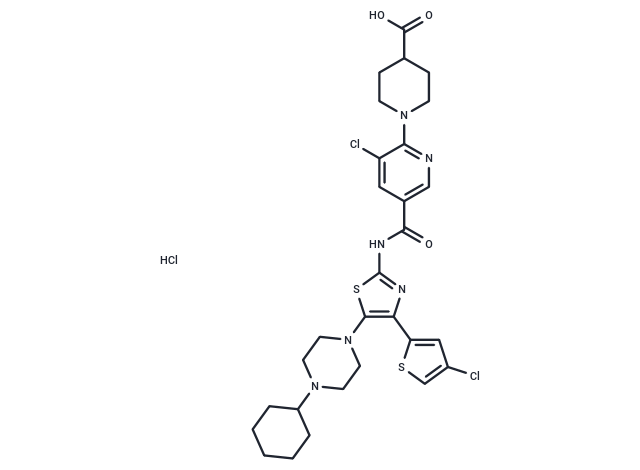Shopping Cart
Remove All Your shopping cart is currently empty
Your shopping cart is currently empty
Avatrombopag hydrochloride (AKR-501) is an orally active, nonpeptide agonist of the thrombopoietin (TPO) receptor with an EC50 of 3.3 nM. It effectively mimics TPO by stimulating platelet production through activation of the intracellular signaling system, facilitating platelet and megakaryocyte generation from hemopoietic precursor cells. Additionally, Avatrombopag hydrochloride serves as a substrate for cytochrome P450 [CYP] 2C9 and CYP3A.

| Pack Size | Price | USA Warehouse | Global Warehouse | Quantity |
|---|---|---|---|---|
| 5 mg | $349 | Inquiry | Inquiry | |
| 10 mg | $498 | Inquiry | Inquiry | |
| 50 mg | $1,490 | Inquiry | Inquiry | |
| 100 mg | Inquiry | Inquiry | Inquiry | |
| 200 mg | Inquiry | Inquiry | Inquiry | |
| 1 mL x 10 mM (in DMSO) | $527 | Inquiry | Inquiry |
| Description | Avatrombopag hydrochloride (AKR-501) is an orally active, nonpeptide agonist of the thrombopoietin (TPO) receptor with an EC50 of 3.3 nM. It effectively mimics TPO by stimulating platelet production through activation of the intracellular signaling system, facilitating platelet and megakaryocyte generation from hemopoietic precursor cells. Additionally, Avatrombopag hydrochloride serves as a substrate for cytochrome P450 [CYP] 2C9 and CYP3A. |
| In vitro | Avatrombopag hydrochloride, also known as E5501 and AKR-501, interacts specifically with the TPO receptor, mirroring the effects of recombinant human TPO (rhTPO) by stimulating megakaryocytopoiesis and aiding in the development and maturation of megakaryocytes. This activity was observed to be effective in humans and chimpanzees only[1]. Additionally, Avatrombopag hydrochloride facilitates the concentration-dependent growth of Ba/F3 cells expressing the TPO receptor, ranging from 0-100 nM. It also initiates the phosphorylation of STAT3, STAT5 (tyrosine), and ERK (threonine) within these cells, comparable to the effects seen with rhTPO[1]. Moreover, it supports the formation of megakaryocyte colonies from human CB CD34+ cells in a concentration-dependent manner, with an EC50 value of 25 nM. The maximal activity of Avatrombopag hydrochloride parallels that of rhTPO[1]. |
| In vivo | Avatrombopag hydrochloride, administered orally at doses ranging from 0.3 to 3 mg/kg daily for 14 days, dose-dependently increases the number of human platelets in NOD/SCID mice transplanted with human FL CD34+ cells. Specifically, administration results in approximately a 2.7-fold increase in platelet numbers at a dosage of 1 mg/kg/day and a 3.0-fold increase at 3 mg/kg/day by day 14 after the initiation of treatment. This effect was observed in an animal model involving NOD/SCID mice implanted with human FL CD34+ cells. |
| Synonyms | YM477hydrochloride, E5501hydrochloride, AKR-501 hydrochloride |
| Molecular Weight | 686.11 |
| Formula | C29H35Cl3N6O3S2 |
| Cas No. | 570403-17-7 |
| Smiles | Cl.OC(=O)C1CCN(CC1)c1ncc(cc1Cl)C(=O)Nc1nc(-c2cc(Cl)cs2)c(s1)N1CCN(CC1)C1CCCCC1 |
| Storage | Powder: -20°C for 3 years | In solvent: -80°C for 1 year | Shipping with blue ice/Shipping at ambient temperature. |
| Size | Quantity | Unit Price | Amount | Operation |
|---|

Copyright © 2015-2026 TargetMol Chemicals Inc. All Rights Reserved.